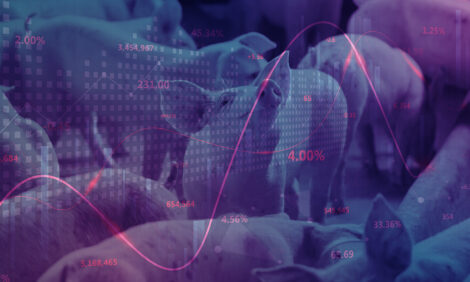



Feeding and Managing Pig Herds Automatically
By Chris Harris, ThePigSite Senior Editor - While tracking and tracing systems have been an essential part of breeding, rearing, slaughtering and processing animals for meat, their use has mainly been as means of assuring quality and food safety. However, the benefits of being able to remotely track and trace individual animals and follow their development are now becoming essential as part of the management of a business.Tracking and tracing, RFID, HACCP, quality assurance schemes and automation are increasingly moving onto the farm and into the factory to provide farmers, managers, vets and breeders with more and more information to help the run their business more efficiently and profitably. The need to manage the information about individual animals is becoming more and more important as the farms get bigger, there is an increasing number of employees and feed costs are rising.
 |
| Nedap's automatic pig feeding station |
On Harry Neulen's pig farm in Wijhe in the east of the Netherlands, the introduction of an Electronic Sow Feeding (ESF) for his sows has helped him grown the business, increase the productivity of the farm and keep costs down.
Since 2002, the farm has grown in size from a 300 sow unit to 650 sows with space for 700 finishing pigs. The remainder of the production is sold on to other finishing units, when the pigs reach 23kg. The farm uses Topig 20 sows and a Tempo boar and produces piglets under the highest welfare standards that are approved for export to the UK.
The growth and improvement in the farm's productivity owes much to the introduction of the automatic feeding station that has been developed by the Dutch electronics and systems management company Nedap. The system allows for individual animal management without the problems of physically checking on the animals several times a day. It takes care of the complete feeding process for the pregnant sows on Mr. Neulen's farm.
The system automatically plots a feeding curve for the animals depending on the age of the animal from gilts to gestating and pregnant sows, giving the animals the optimum feed rations to produce the best condition and the highest productivity. For instance in the winter, between January and March, the system gives the animals 100 grams extra feed to counter the loss of condition because of the cold weather. "The system supports the sows while they are developing in their pregnancy," said Mr Neulen.
"While before when the sows were in the crates they were in good condition, now you can get the best results by fine tuning the feeding regimes without additional labour input."
Mr Neulen's farm buys in 32 gilts every six weeks and grows them on. When the gilts are brought in they are separated from the rest of the herd and put into a special group pen with their own ESF to train them in the new feed regime and programme.
With the greater attention to the feeding regimes, Mr Neulen, is now increasing his production reaching 26 piglets per sow per year.
"Good management will get you between 20 and 22 piglets, but individual feed management will enable you to get more," said Gerard Weijers from Nedap Agri.
"It helps in good sow management to achieve the best physical condition to support and increase production."
The sows are fed on a six stage feed curve following farrowing through to gestation with the aim to send them through to the farrowing house in the best possible condition. The feeding regime follows a feed graph laid out from zero to 115 days and each feeding unit is capable to handling between 45 and 60 sows a day.
One of the feed regime adjustments that the Nedap system can support is that for a more productive farrowing period, the sows need an increased feed at the start of the gestation period rather than at the end.
Mr Neulen has also found that that because his sows were putting on too much condition, he could simply adjust the amount he was feeding on herd and group level and so reduce his costs.
The system works through a transponder in the sow's ear tag. Every time the sow goes to the feeding station, the technology records how much feed the animal is taking and controls the feed to a stipulated amount.
However, not only does the Nedap system automatically control the feed, it also has other benefits that allow the farmer. The system will also record the activity of the sows and the number of times it shows interest in the boar in a neighbouring pen. As this activity increases, it indicates the sow is on heat and is ready either to go with the boar or for artificial insemination. This allows the farmer to obtain the optimum results in production. This is a big time-saver as the alternative is to walk the boar through the house twice a day.
The system also allows the farmer to find a sow if she gets into the wrong pen and it will record if a sow does not take all her feed or misses a feed, indicating that there could be something wrong with the animal.
The system is an internet based programme, so that can be controlled remotely from any computer connected to the farm network or the internet. The Velos system will update its software automatically when Nedap releases new versions. With the use of a camera, the Nedap system also allows the farmer not only to read the results of each animal as it enters the feeding station, but also to see the behaviour and condition of the animals in the pens remotely.
According to Mr Weijers at Nedap, the success of the system with growing farm sizes, is that it reduces labour costs and manages the feed for the pigs on an individual basis.
He said that when a farm grows to 10 times its size, costs will rise, but production per animal slows down. The problem is to provide individual management on a large scale.
Mr Weijers said that the automatic feeding system empowers the human element by reducing boring routines, increasing efficiency and preventing mistakes. Pigs are no longer managed on an average basis, because the average pig does not exist.
The programme is operated from a server platform based on the farm that is easily repaired in the event of a breakdown. It can also be operated in a variety of languages to accommodate the international nature of the workforce today.
Nedap claims that the Velos system will save up to 20 per cent on feed, 20 per cent on labour costs and will increase production by 15 per cent.
November 2007








